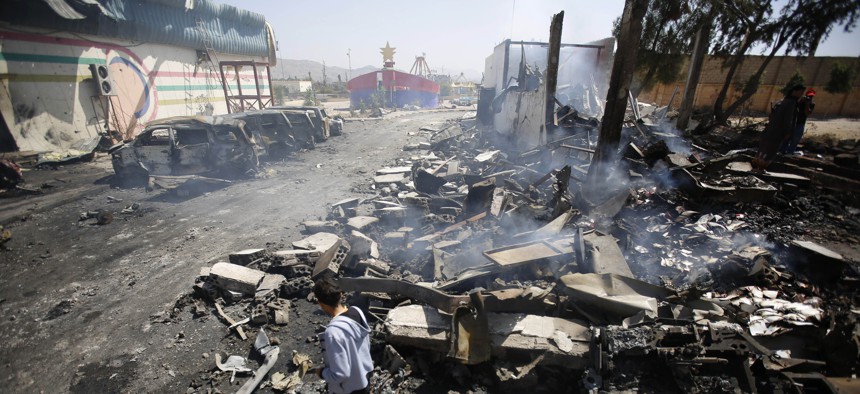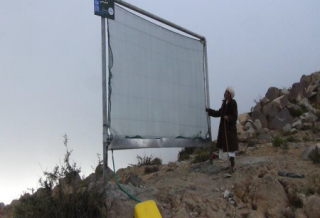
A Yemeni man inspects the site of Saudi-led airstrikes in Sanaa, Yemen, Friday, Feb. 12, 2016. Hani Mohammed/AP
To Survive a War, Yemenis Are Turning Fog Into Water
Yemen had a serious water shortage even before fighting intensified in 2015. Now, increasingly desperate villages are experimenting with ways to 'harvest' moisture from the air.
The people of Yemen are facing incredible hardship at the moment: As if internal fighting and air strikes weren’t enough, food and water are scarce in the area, due to Saudi blockade on imports, isolation from humanitarian routes, and a tough natural climate. But there is one resource no one can take away: Yemen’s fog.
Already a region beset with serious water shortages in peacetime , Yemen’s yearly rainfall is only about 900 million cubic meters, or three quarters of what it needs, according to 2003 data from Sana’a University . Many must travel for hours to fetch water, and the country’s capital risks running out of water as soon as 2017.
Yemen is a poor country, but it has plenty of fog. Now some villages are experimenting with ways to “harvest” that moisture from the air.

Fog harvesting, a technique practiced in countries including Chile, Morocco, Guatemala and Haiti, has been tested in Yemen since 2003, though results were not encouraging until 2013 . Since then, the United Nations Development Programme (UNDP), together with Yemen’s National Foundation for Watershed Management, have reported success in harvesting fog in the western part of the country .
Fog harvesting devices are mesh screens that condense fog as it passes through. Yemen’s latest fog-harvesting project, an installment of 200 screens, was kept up by UNDP-led efforts until Dec. 2014 in the Manakha Mount area. It has since been taken over by the local community, benefitting over 1,500 people who would otherwise face shortages, according to UNDP . Each screen collects at least 40 liters of water each, per day.
At $15 per fog screen, Yemen could conceivably scale up the pilot project to draw water from air in other areas of the country, too.
NEXT STORY: The Military’s Super-Fast Bird Drone





